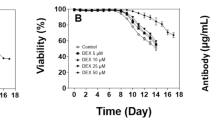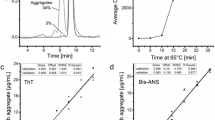Abstract
Interchain disulfide bonds in monoclonal antibodies may be reduced during large-scale mAb production using Chinese hamster ovary (CHO) cells. This reaction lowers the mAb product yield and purity; however, it may be prevented by screening cell lines that are unsusceptible to reduction and using them in mAb production. Antibody reduction susceptibility may be cell line-dependent. To the best of our knowledge, however, an efficient method of screening reduction-unsusceptible CHO cell lines has not been previously reported. Here, we report a novel screening method that can simultaneously detect and identify mAb reduction susceptibility in lysates containing ≤ 48 CHO cell lines. This evaluation system was equally effective and generated similar results at all culture scales, including 250 mL, 3 L, and 1000 L. Furthermore, we discovered that reduction-susceptible cell lines contained higher total intracellular nicotinamide adenine dinucleotide phosphate (NADPH) and NADP+ concentrations than reduction-unsusceptible cell lines, regardless of whether they expressed immunoglobulin (Ig)G4 or IgG1. NADPH or NADP+ supplementation in the lysate of reduction-unsusceptible cells resulted in mAb reduction. Application of the innovative CHO cell line screening approach could mitigate or prevent reductions in large-scale mAb generation from CHO cells.






Similar content being viewed by others
Data availability
The datasets generated during and/or analyzed during the current study are available from the corresponding author on reasonable request.
References
Chevallier V, Andersen MR, Malphettes L (2020) Oxidative stress-alleviating strategies to improve recombinant protein production in CHO cells. Biotechnol Bioeng 117:1172–1186. https://doi.org/10.1002/bit.27247
Chung WK, Russell B, Yang Y, Handlogten M, Hudak S, Cao M, Wang J, Robbins D, Ahuja S, Zhu M (2017) Effects of antibody disulfide bond reduction on purification process performance and final drug substance stability. Biotechnol Bioeng 114:1264–1274. https://doi.org/10.1002/bit.26265
Cura AJ, Xu X, Egan S, Aron K, Jenkins L, Hageman T, Huang Y, Chollangi S, Borys M, Ghose S, Li ZJ (2020) Metabolic understanding of disulfide reduction during monoclonal antibody production. Appl Microbiol Biotechnol 104:9655–9669. https://doi.org/10.1007/s00253-020-10916-1
Derfus GE, Dizon-Maspat J, Broddrick JT, Velayo AC, Toschi JD, Santuray RT, Hsu SK, Winter CM, Krishnan R, Amanullah A (2014) Red colored IgG4 caused by vitamin B12 from cell culture media combined with disulfide reduction at harvest. mAbs 6:679–688. https://doi.org/10.4161/mabs.28257
Du C, Huang Y, Borwankar A, Tan Z, Cura A, Yee JC, Singh N, Ludwig R, Borys M, Ghose S, Mussa N, Li ZJ (2018) Using hydrogen peroxide to prevent antibody disulfide bond reduction during manufacturing process. mAbs 10:500–510. https://doi.org/10.1080/19420862.2018.1424609
Gao Y, Ray S, Dai S, Ivanov AR, Abu-Absi NR, Lewis AM, Huang Z, Xing Z, Borys MC, Li ZJ, Karger BL (2016) Combined metabolomics and proteomics reveals hypoxia as a cause of lower productivity on scale-up to a 5000-liter CHO bioprocess. Biotechnol J 11:1190–1200. https://doi.org/10.1002/biot.201600030
Gromer S, Urig S, Becker K (2004) The thioredoxin system–from science to clinic. Med Res Rev 24:40–89. https://doi.org/10.1002/med.10051
Handlogten MW, Zhu M, Ahuja S (2017) Glutathione and thioredoxin systems contribute to recombinant monoclonal antibody interchain disulfide bond reduction during bioprocessing. Biotechnol Bioeng 114:1469–1477. https://doi.org/10.1002/bit.26278
Handlogten MW, Wang J, Ahuja S (2020) Online control of cell culture redox potential prevents antibody interchain disulfide bond reduction. Biotechnol Bioeng 117:1329–1336. https://doi.org/10.1002/bit.27281
Henry MN, MacDonald MA, Orellana CA, Gray PP, Gillard M, Baker K, Nielsen LK, Marcellin E, Mahler S, Martínez VS (2020) Attenuating apoptosis in chinese hamster ovary cells for improved biopharmaceutical production. Biotechnol Bioeng 117:1187–1203. https://doi.org/10.1002/bit.27269
Hutterer KM, Hong RW, Lull J, Zhao X, Wang T, Pei R, Le ME, Borisov O, Piper R, Liu YD, Petty K, Apostol I, Flynn GC (2013) Monoclonal antibody disulfide reduction during manufacturing: untangling process effects from product effects. mAbs 5:608–613. https://doi.org/10.4161/mabs.24725
Kao FT, Puck TT (1968) Genetics of somatic mammalian cells, VII. Induction and isolation of nutritional mutants in chinese hamster cells. Proc Natl Acad Sci USA 60:1275–1281. https://doi.org/10.1073/pnas.60.4.1275
Kao YH, Hewitt DP, Trexler-Schmidt M, Laird MW (2010) Mechanism of antibody reduction in cell culture production processes. Biotechnol Bioeng 107:622–632. https://doi.org/10.1002/bit.22848
Kaplon H, Muralidharan M, Schneider Z, Reichert JM (2020) Antibodies to watch in 2020. mAbs 12:1703531. https://doi.org/10.1080/19420862.2019.1703531
Koterba KL, Borgschulte T, Laird MW (2012) Thioredoxin 1 is responsible for antibody disulfide reduction in CHO cell culture. J Biotechnol 157:261–267. https://doi.org/10.1016/j.jbiotec.2011.11.009
Kunert R, Reinhart D (2016) Advances in recombinant antibody manufacturing. Appl Microbiol Biotechnol 100:3451–3461. https://doi.org/10.1007/s00253-016-7388-9
Lalonde ME, Durocher Y (2017) Therapeutic glycoprotein production in mammalian cells. J Biotechnol 251:128–140. https://doi.org/10.1016/j.jbiotec.2017.04.028
Liu H, Nowak C, Shao M, Ponniah G, Neill A (2016) Impact of cell culture on recombinant monoclonal antibody product heterogeneity. Biotechnol Prog 32:1103–1112. https://doi.org/10.1002/btpr.2327
Mullan B, Dravis B, Lim A, Clarke A, Janes S, Lambooy P, Olson D, O’Riordan T, Ricart B, Tulloch AG (2011) Disulphide bond reduction of a therapeutic monoclonal antibody during cell culture manufacturing operations. BMC Proc 5:P110. https://doi.org/10.1186/1753-6561-5-S8-P110
Mun M, Khoo S, Do Minh A, Dvornicky J, Trexler-Schmidt M, Kao YH, Laird MW (2015) Air sparging for prevention of antibody disulfide bond reduction in harvested CHO cell culture fluid. Biotechnol Bioeng 112:734–742. https://doi.org/10.1002/bit.25495
Nelson AL, Dhimolea E, Reichert JM (2010) Development trends for human monoclonal antibody therapeutics. Nat Rev Drug Discov 9:767–774. https://doi.org/10.1038/nrd3229
O’Flaherty R, Bergin A, Flampouri E, Mota LM, Obaidi I, Quigley A, Xie Y, Butler M (2020) Mammalian cell culture for production of recombinant proteins: a review of the critical steps in their biomanufacturing. Biotechnol Adv 1:107552. https://doi.org/10.1016/j.biotechadv.2020.107552
O’Mara B, Gao ZH, Kuruganti M, Mallett R, Nayar G, Smith L, Meyer JD, Therriault J, Miller C, Cisney J, Fann J (2019) Impact of depth filtration on disulfide bond reduction during downstream processing of monoclonal antibodies from CHO cell cultures. Biotechnol Bioeng 116:1669–1683. https://doi.org/10.1002/bit.26964
Park SY, Egan S, Cura AJ, Aron KL, Xu X, Zheng M, Borys M, Ghose S, Li Z, Lee K (2021) Untargeted proteomics reveals upregulation of stress response pathways during CHO-based monoclonal antibody manufacturing process leading to disulfide bond reduction. mAbs 13:1963094. https://doi.org/10.1080/19420862.2021.1963094
Ren T, Tan Z, Ehamparanathan V, Lewandowski A, Ghose S, Li ZJ (2021) Antibody disulfide bond reduction and recovery during biopharmaceutical process development – a review. Biotechnol Bioeng 118:2829–2844. https://doi.org/10.1002/bit.27790
Ritacco F, Wu Y, Khetan A (2018) Cell culture media for recombinant protein expression in chinese hamster ovary (CHO) cells: history, key components, and optimization strategies. Biotechnol Prog 34:1407–1426. https://doi.org/10.1002/btpr.2706
Shukla AA, Thömmes J (2010) Recent advances in large-scale production of monoclonal antibodies and related proteins. Trends Biotechnol 28:253–261. https://doi.org/10.1016/j.tibtech.2010.02.001
Templeton N, Dean J, Reddy P, Young JD (2013) Peak antibody production is associated with increased oxidative metabolism in an industrially relevant fed-batch CHO cell culture. Biotechnol Bioeng 110:2013–2024. https://doi.org/10.1002/bit.24858
Trexler-Schmidt M, Sargis S, Chiu J, Sze-Khoo S, Mun M, Kao YH, Laird MW (2010) Identification and prevention of antibody disulfide bond reduction during cell culture manufacturing. Biotechnol Bioeng 106:452–461. https://doi.org/10.1002/bit.22699
Walsh G (2018) Biopharmaceutical benchmarks 2018. Nat Biotechnol 36:1136–1145. https://doi.org/10.1038/nbt.4305
Xiao W, Wang RS, Handy DE, Loscalzo J (2018) NAD(H) and NADP(H) redox couples and cellular energy metabolism. Antioxid Redox Signal 28:251–272. https://doi.org/10.1089/ars.2017.7216
Zhou JX, Tressel T, Yang X, Seewoester T (2008) Implementation of advanced technologies in commercial monoclonal antibody production. Biotechnol J 3:1185–1200. https://doi.org/10.1002/biot.200800117
Acknowledgements
We thank Yuka Mashio for helping with sample preparation and Mayumi Kaniwa and Misaki Furuie for helping with cell culture. We would like to thank Editage (www.editage.com) for English language editing.
Author information
Authors and Affiliations
Contributions
Conceptualization: TY; Methodology: TY; Formal analysis and investigation: TY, MF, YM, TM, SK; Writing—original draft preparation: TY; Writing—review and editing: TY, RN, KY, KW; Supervision: KY, KW.
Corresponding author
Ethics declarations
Competing interest
The authors declare no competing interests.
Additional information
Publisher’s Note
Springer Nature remains neutral with regard to jurisdictional claims in published maps and institutional affiliations.
Rights and permissions
Springer Nature or its licensor (e.g. a society or other partner) holds exclusive rights to this article under a publishing agreement with the author(s) or other rightsholder(s); author self-archiving of the accepted manuscript version of this article is solely governed by the terms of such publishing agreement and applicable law.
About this article
Cite this article
Yamaguchi, T., Fukuda, M., Matsumoto, Y. et al. New high-throughput screening method for Chinese hamster ovary cell lines expressing low reduced monoclonal antibody levels: application of a system controlling the gas phase over cell lysates in miniature bioreactors and facilitating multiple sample setup. Cytotechnology 75, 421–433 (2023). https://doi.org/10.1007/s10616-023-00587-x
Received:
Accepted:
Published:
Issue Date:
DOI: https://doi.org/10.1007/s10616-023-00587-x




